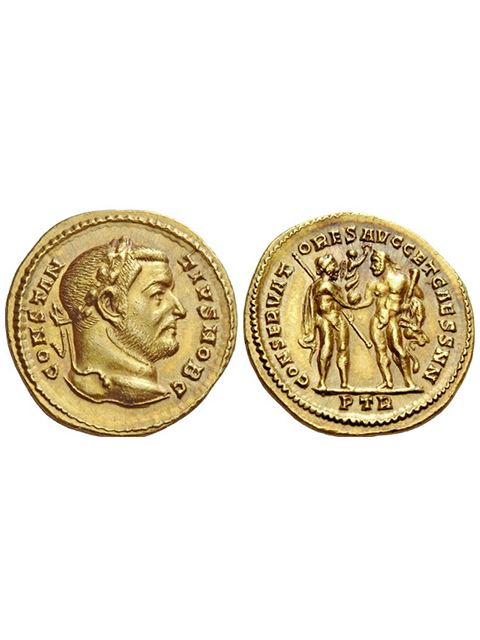在位期間: Augustus(皇帝として)紀元後305年〜306年 (1年2ヶ月24日間)!
重量: 5,15グラム
ミント: トリーア(現:ドイツTrier市)
表面: 皇帝の有冠Head「CONSTANTIVS NOB C」
裏面: 「3神」
1:「最高神ユーピテル」ローマ神話神々の王、主神である!手に「笏」。
2:「ヘラクレス」(ギ神、ロ神)最高神Zeus/Jupiterの息子である! ライオン皮を冠る。
3: 「勝利の女神」両神(ユーピテル/ヘラクレス)が手を繋いで、その上に持ってるのは、「球体」(太陽?) 上に(勝利の女神)VICTORY.
「CONSERVA – TORES AVGG ET CAESS NN」18時方向「PTR」。
NGC鑑定番号: 3988028-001
NGC鑑定結果: 「MS STAR」 5/5、5/5 !!
専門参考書:
RIC 41. Beaurains 384 (THIS COIN)!
Depeyrot 8/3. Biaggi 1848 (THIS COIN)!!
Calicó 4817 (THIS COIN)!!!
オークション歴:
1: 1950年11月: Glendining & Co., London, 16-21 (lot 1996).
2: 「Leo Biaggi de Blasys (1906-1979) COLLECTION」 acquired privately in 1978 (スイス国チューリッヒ市「LEU銀行」が購入) Bank Leu (Zürich) !
3: 1979年5月8日: (Bank LEU, auction 22, lot 373).
4: 1990年12月04日:「Nelson Bunker Hunt (1926-2014) COLLECTION (part III)」sold by Sotheby’s, auction 6054, New York (lot 99)。
5: 2005年5月10日:「Claude Vaudecrane (1915-2002) COLLECTION」sold by Leu Numismatics, Zürich, auction 93 (A Perfectionist) (Lot 126).
6: 2017年5月29日: NAC (Numismatica Ars Classica) Auction 99 (Lot 45) (裸コインで!) Hammerで80.000スイスフラン(落札手数料込みで、約100.000スイスフラン)BP込みで、約「1350万円」。
Le 「Trésor d'Arras」 (又はtrésor de Beaurains)
1922年9月21日、フランス共和国Pas-de-Calais地方「Beaurains Les Arras」付近で、コイン学に於いても、古今東西において(煉瓦職人達によって)発見されてきた「ローマ帝国時代」の財宝の中でも、「史上」最高の一つです。
近くに駐屯していた帝国軍の財宝か、あるいは帝王の最高位の側近が「紀元後315年」頃に、地中に隠されたと思われます。
兎に角、「アラス財宝」は、天下一品が複数で、最も貴重で、博物館やコレクターにとっても、この上なく、最も「垂涎の的」の収集対象である。
発見当時:
アンフォラの中に、カメオ、ジュエリー、銀製食器など、そして銀製の箱の中に「銀貨/金貨/メダヨン」も発見されました。Total:約700点 !!
(約)紀元後315年に土葬された財宝構成:
Roman High-Empire (紀元前27年〜紀元後200年)迄の間のコインは83個(金貨1枚、銀貨82枚)
Roman Low-Empire (紀元後200年〜315年迄)の間に鋳造されたコインは389個(内:メダヨン25個)。
Arras財宝最大の宝は、世界で唯一知られる「アウレウス金貨10個分」超弩級52グラムもする「コンスタンティウス クロロス」のメダヨン(Medaillon)(鋳造地:ドイツのトリーア): 大英博物館所蔵!!
Arras市は特別予算と裕福層の篤志家達の寄付で、1927年、市が発見者達から財宝の半分以上購入。
そのArras市に買われた「Arras美術館」所蔵ですが、遺憾ながら「一般公開は今迄一切なし」!
「大英博物館」:
世界中の博物館などが押し寄せたが、結果的に、すぐに個人と個人の間に取引されていたコイン以外はイギリス「大英博物館」に、財宝の一部が購入。
「ベルギー国王」:
金貨18枚は「ベルギー国王メダルカビネット」に買われ、厳重に保管されています。
「英国Oxford市」など。。。
本品:
世界で初めて発見された、このコインは3個しか存在しなかった。
1つ目は: 最上状態が本品です。
2つ目は: 大英博物館が(1924年)購入し所蔵:
3つ目は: Arras美術館所蔵。
最近/最新情報: フランス政府「Banque De France」(フランス国立銀行)経由で「アラス財宝」から個人所蔵で,買われたいた「メダヨン5個」を今年(2021年4月)に「最重要国宝指定」し、国の権限で「政府命令」ですと、「国宝」という指定受けて「一方的な売却命令」(2.800.000ユーロ以上)の金額(約4億円)で購入。
2022年、発見から「100周年」記念、Arras市美術館所蔵の一部が、史上初めてパリ「Citeco」で空前にして絶後の「特設公開」されます。
Provenance
Found in a field in ”Pouvoir Dhée”, near Beaurains lès Arras, on 21 September 1922.
H. Platt Hall, Esq. (1863-1949) Collection (part II),
A magnificent portrait of 「EXQUISITE STYLE」 and an interesting and finely detailed.
「CONSTANTIUS CHLORUS」
フラウィウス・ウァレリウス・コンスタンティウス(ラテン語: Flavius Valerius Constantius
生まれ:250年3月31日(306年7月25日崩御)
ローマ帝国の皇帝(305年〜306年)。コンスタンティウス1世とも。一般に χλωρός, Chloros(Chlorus)クロロス(クロルス、「青白い」という意味のギリシア語)と呼ばれているが、これは後の東ローマ帝国時代の歴史家たちが付けたあだ名である。
コンスタンティヌス1世の父で、コンスタンティヌス朝の創始者である!
キリスト教の伝説:
コンスタンティヌス大帝の父として、キリスト教ではコンスタンティウスにまつわるいくつも伝説が語られてきた。エウセビオスの『コンスタンティヌスの生涯』によると、父コンスタンティウス自身は非キリスト教徒を装っていたが実はキリスト教徒で、ディオクレティアヌスの副帝だった時代にも、皇帝によるキリスト教迫害には加担しなかったという。さらに、彼の最初の妻ヘレナ(コンスタンティヌス大帝の生母)については、聖十字架の発見をはじめ、多くの伝説が残されている。。。
English Version
On March 1, AD 293, the Roman world was significantly changed when the Augustus (senior emperor) Diocletian and his Caesar (junior emperor) Maximianus reorganized the Empire to be administered by two Augusti and two Caesars. In this new system, known as the Tetrarachy, one Augustus and Caesar would be responsible for the Western Empire while the other would handle the East. Maximianus was named Augustus in the West and appointed his son-in-law,Constantius Chlorus, as his Caesar while Diocletian elevated his own son-in-law, Galerius, to be his Caesar.
This aureus depicts Constantius as Caesar on the obverse and celebrates his elevated relationship to Maximianus on the reverse.
Already in AD 287, Diocletian and Maximianus had made a point of closely associating themselves with Jupiter and Hercules.
「Jupiter」was tied to Diocletian and with the office of Augustus while 「Hercules」was linked to Maximianus and the position of Caesar.
Diocletian took to referring to himself as Jovianus and to Maximianus as Herculius as a means of casting themselves as agents of the divine and elevating their authority beyond the mortal realm. In keeping with this custom, Constantius added the name Herculius to his own nomenclature during his tenure as Caesar.
Here we see Jupiter passing the victoriola — a symbol of victory and power — on to Hercules in what is almost certainly an allegory for the relationship between the Augusti and Caesars of the Tetrarchy.
Like Jupiter, the Augusti make the plans and give the commands, thereby placing victory in the hands of the subordinate heroes, the Caesars. The connection between the depicted gods and the senior and junior members of the Tetrarchy is further underlined by the reverse legend, which describes Jupiter and Hercules as the ”Defenders of Our Augusti and Caesars.”
It has been suggested that this coin — one of only three from the Arras hoard — was struck as a donative for the army on the occasion of the vicennalia (20-year anniversary) of the reign of Maximianus, which was celebrated on November 20, AD 303!
